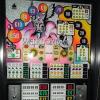This is an interesting old tech and getting to be quite rare these days. Luckily manuals and schematics are available (in downloads) which makes things a whole lot easier.
Before starting work on this tech I cut my teeth on the System 1000 which is very similar in construction. I've yet to document that one but one useful part of the project is that both techs can use the same tester I've built along with Bell Fruit Black Box.
Here's a quick outline of all the cards and chassis.....
I couldn't get hold of any 22 way molex connectors but luckily I had managed to get some 24 way ones from Digikey for the 1000 cards and had just enough spares to trim them down.
Starting with the PSU card. They used a very odd arrangement of obtaining a 5v supply for the logic. The main supply (15v) is dropped to 10v and this is then used as the negative for the logic chips, the 15v rail then making the +5v, if that makes sense. I did read an article about the reason for doing it this way and at the time it was the standard way to do it. Wish I'd read that first as taking initial voltage readings was extremely confusing.
The next cards are the CPU's. Two types have surfaced so far, C1 and issue 3. The first is the C1 variant and the next two issue 3's but some have only one ROM no RAM and no battery components.
The CPU is the 4040 24 way chip so it's only a 4 bit device. The clock and RST is generated by the P4201 chip top left and these are prone to fail. Spares are non existent!
Next is the I/O cards. Triac and transistor ouput.
Lastly the input card.
Most the I/O circuitry uses the same or similar format of ACE techs right through to System one so there's no head scratchers there.
Of course things would be too easy if there weren't any any at all and lo and behold we come to the reel deck. There's no documentation on this so it had to be worked out from the physical deck. The principle used is similar to the old mechanical Bell Fruit decks with studs and wipers except they took a leap into technology and made it all electrical. Basically the reel has 20 positions with various slots cut into an attached sensor wheel. This then has 5 LED sensors to report the wheel position back to the program. Considering the motor arrangement is similar to the Bell Fruit it's quite clever how it works. There are slots cut in the outside of the sensor wheel which locks/stops the reel when its associated solenoid is released.
It didn't take too long to sus out that the 5 sensors are used to translate the reel position into binary. As I didn't have a reel deck I needed to be able to create one in software on my Arduino. The basic code has been written but not tried as yet due to PSU issues with the test rig but hopefully this won't take too long to resolve.
My understanding is the reel sensors are read at every position due to the slots ( 1 per position) on the outside circumference of the sensor wheel. When the program knows it's at the correct position it releases the solenoid to stop the reel. Any old hands out there, please feel free to educate me if this isn't correct or you'd like to add anything.
So far I've managed to get all the CPU's to run and a couple of PSU's. No I/O cards have yet been worked on as the PSU supply from my test rig doesn't have enough power to run them and a larger transformer is needed. Once sorted I'll update this thread, hopefully with a working system.






